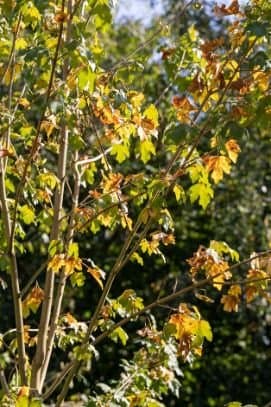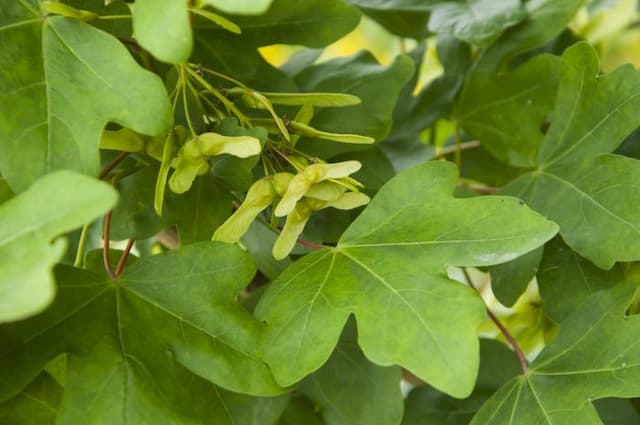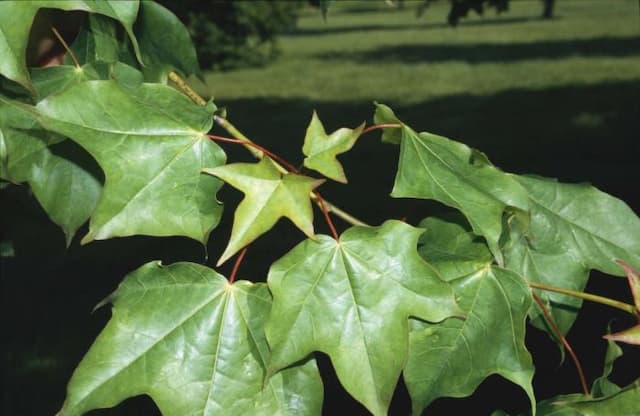Japanese Maple Acer palmatum 'Marlo' (PBR) (D)

ABOUT
The Japanese maple 'Marlo' is a captivating variety recognized for its distinctive foliage and stunning seasonal transitions. Its leaves are intricately shaped with multiple lobes, often resembling the palm of a hand or a delicate star, hence its association with the name "palmatum." These lobes are finely serrated along the edges, adding a feathery appearance to the foliage texture. In spring, the leaves burst forth with vivid colors, presenting an eye-catching display. They feature a blend of hues, ranging from deep purple to bright red, and sometimes display a variegated pattern with intricate mixtures of shades edged with cream or pink tones. As the seasons progress, the leaves undergo a visual transformation; the summer sun may mellow the vibrancy to a subtle burgundy or bronze palette. Come autumn, the Japanese maple 'Marlo' does not shy away from the spotlight. It puts on a spectacular show as the leaves turn again, this time adopting fiery shades of red, orange, and golden yellow, creating a warm tapestry of colors that stand out in any garden landscape. The branching structure of the tree is equally elegant, with a framework that supports the decorative foliage. The branches gracefully spread outward, layering in a manner that accentuates the plant's overall form. The bark on the trunk and limbs adds another level of aesthetic appeal with its smooth texture and sometimes slightly contrasting color to the leaves above. Altogether, the Japanese maple 'Marlo' stands as a highly ornamental plant that brings seasonal interest and a touch of exotic beauty to its surroundings. Its colors and textures make it a prominent feature in any garden, offering a beautiful backdrop or acting as a striking centerpiece.
About this plant
 Names
NamesFamily
Sapindaceae
Synonyms
Marlo Japanese Maple
Common names
Acer palmatum 'Marlo' (PBR) (D).
 Toxicity
ToxicityTo humans
The Japanese Maple is generally not considered toxic to humans. Ingesting normal, small quantities of plant parts like leaves is unlikely to cause serious harm or any symptoms of poisoning in humans. However, in rare cases or when large amounts are consumed, the ingestion of any part of the plant may lead to gastrointestinal discomfort or mild symptoms like nausea or vomiting.
To pets
The Japanese Maple is not known to be toxic to pets. It is generally safe for dogs, cats, and other household animals. Ingesting the leaves or other parts of the plant usually does not lead to poisoning or serious health issues. However, if a pet ingests large quantities, it might experience mild gastrointestinal upset, although this is relatively uncommon.
 Characteristics
CharacteristicsLife cycle
Perennials
Foliage type
Deciduous
Color of leaves
Varies
Height
6-8 feet (1.8-2.4 meters)
Spread
6-8 feet (1.8-2.4 meters)
Plant type
Tree
Hardiness zones
5-8
Native area
Japan
Benefits
 General Benefits
General Benefits- Ornamental Appeal: The Acer palmatum 'Marlo', commonly known as Japanese Maple, is prized for its unique foliage coloration and shape, adding aesthetic appeal to any garden.
- Seasonal Interest: This cultivar offers a variety of colors throughout the seasons, from spring to autumn, providing year-round visual interest.
- Compact Size: It remains relatively small, making it suitable for smaller gardens or spaces, and can also be grown in containers.
- Shade Tolerance: Japanese Maple 'Marlo' can tolerate partial shade, allowing for versatile planting locations within the landscape.
- Fall Color: The leaves turn striking shades of red, orange, or gold in the autumn, creating a spectacular display.
- Low Maintenance: Once established, it requires minimal care, only needing occasional pruning to maintain its shape and health.
- Attracts Wildlife: The tree can attract birds and beneficial insects, promoting biodiversity in the garden.
- Slow Growing: Its slow growth rate means it rarely outgrows its space or needs extensive pruning.
 Medical Properties
Medical PropertiesThis plant is not used for medical purposes.
 Air-purifying Qualities
Air-purifying QualitiesThis plant is not specifically known for air purifying qualities.
 Other Uses
Other Uses- Bonsai Cultivation: The Japanese Maple 'Marlo' can be pruned and trained as a bonsai, offering an artistic outlet and a meditative hobby.
- Photography: Owing to its stunning foliage, 'Marlo' can serve as a picturesque subject for photography enthusiasts, especially during autumn.
- Leaf Castings: The leaves of 'Marlo' can be used to make decorative leaf castings for garden art or home decoration.
- Seasonal Celebrations: In Japanese culture, viewing parties (momijigari) are held to appreciate the autumn colors, with 'Marlo' being a splendid example.
- Education: 'Marlo' is an example plant in horticulture classes to teach about plant care, pruning, and leaf structure.
- Pattern Inspiration: The leaves can inspire patterns in textiles, wallpaper designs, or in other artistic creations.
- Theme Gardens: 'Marlo' can be used as a focal plant in theme gardens, like a zen garden, where its aesthetic is appreciated among rocks and sand patterns.
- Landscape Contrast: Due to its colorful leaves, 'Marlo' can be utilized to create contrast in landscaping designs, pairing well with evergreens or grasses.
- Seasonal Arrangements: Its leaves and branches can be incorporated into floral arrangements, especially in the fall for seasonal décor.
- Feng Shui: In Feng Shui, placing a Japanese Maple in the garden is believed to bring balance and positive energy, making 'Marlo' a choice for this purpose.
Interesting Facts
 Feng Shui
Feng ShuiThe Japanese Maple, being a harmonious plant with calming foliage, can be used in Feng Shui to enhance the energy of a space. It's ideal for the East (health and family) and Southeast (wealth and abundance) areas of a garden or home to promote balance and prosperity. The fiery colors of the 'Marlo' variety could also energize a space without overwhelming it, embodying the Feng Shui principle of balance.
 Zodiac Sign Compitability
Zodiac Sign CompitabilityThe Japanese Maple is not used in astrology practice.
 Plant Symbolism
Plant Symbolism- Japanese Maple: This plant often signifies peace and serenity, reflecting the calm and tranquil environments of Japanese gardens where it is commonly found.
- Japanese Maple: It can represent balance and practicality, as the tree's delicate appearance and hardy nature balance aesthetic beauty with the resilience needed to survive in changing climates.
- Japanese Maple: Symbolic of grace and elegance, the plant's intricate leaf patterns and refined growth habit evoke a sense of subtlety and sophistication.
- Japanese Maple: The Japanese Maple is also associated with love and romance, possibly because of its vibrant fall colors, reminiscent of passion and intensity.
 Water
WaterJapanese maples like Acer palmatum 'Marlo' should be watered thoroughly but infrequently, allowing the soil to dry out slightly between watering sessions. During the growing season, a deep watering once a week may be sufficient, with young trees or trees in containers possibly requiring more frequent watering, possibly twice a week. It's important to use enough water to reach the roots; for a mature tree in the ground, this could mean 10 to 15 gallons per watering session. In extreme heat or drought conditions, you may need to increase watering frequency, while in cooler seasons or rainy weather, reduce the amount and frequency to prevent waterlogging.
 Light
LightJapanese maples such as Acer palmatum 'Marlo' perform best in a spot that receives full to partial sunlight, with protection from the harshest midday sun, which can scorch their delicate leaves. They thrive in an area where they get morning sun and afternoon shade, or filtered sunlight throughout the day, which can help in maintaining the vibrancy of their foliage.
 Temperature
TemperatureJapanese maples like Acer palmatum 'Marlo' prefer temperate conditions and are hardy in a range from approximately 20 to 85 degrees Fahrenheit. They can tolerate cold down to about -10 to -20 degrees Fahrenheit but need protection from extreme cold winds. An ideal temperature range for active growth is between 60 and 70 degrees Fahrenheit.
 Pruning
PruningPrune Japanese maples like Acer palmatum 'Marlo' mainly to remove dead or damaged branches and to maintain shape. Light pruning can be done anytime, but major pruning should be performed during the dormant season, late fall to winter. This timing minimizes sap loss and stress to the tree. Pruning every 2-3 years will typically suffice to keep the tree healthy and looking its best.
 Cleaning
CleaningAs needed
 Soil
SoilJapanese Maple prefers well-draining, fertile soil with a pH of around 5.5 to 6.5. A mixture of loam, compost, and coarse sand or perlite can create an ideal growing medium. Regular mulching helps maintain soil moisture.
 Repotting
RepottingYoung Japanese Maples should be repotted every two or three years; mature trees can be repotted less frequently, approximately every four to five years, to refresh the soil.
 Humidity & Misting
Humidity & MistingJapanese Maples generally prefer average humidity levels and do not require any special humidity considerations beyond the natural outdoor environment.
 Suitable locations
Suitable locationsIndoor
Ensure bright indirect light, well-draining soil, and occasional pruning for size.
Outdoor
Plant in partial shade, protect from strong winds, and mulch soil surface.
Hardiness zone
5-9 USDA
 Life cycle
Life cycleThe life cycle of the Japanese Maple 'Marlo' begins with seed germination, where the plant emerges from stratified seeds typically sown in the fall or spring, requiring evenly moist, well-draining soil and appropriate temperatures to sprout. After germination, the seedling stage follows, during which it slowly develops its characteristic leaf shape and branching pattern over several years, requiring partial to full sunlight and regular watering. The young tree then enters the sapling phase, continuing to establish its root system and increasing in height and canopy spread, benefiting from occasional fertilization. As it matures into an adult tree, the Japanese Maple 'Marlo' develops a more complex and aesthetically pleasing structure, with notable red and purple foliage during the growing season and increased resilience to environmental stress. During its mature stage, it produces small flowers in spring, followed by winged samaras, and requires minimal maintenance aside from potential shaping or pruning for aesthetics and health. Finally, after many decades, as it reaches the end of its life, growth slows, and it may become more susceptible to diseases and pests, ultimately leading to its senescence and death.
 Propogation
PropogationPropogation time
Spring-Early Summer
Propogation: Acer palmatum 'Marlo', commonly known as Japanese maple, is most successfully propagated through softwood cuttings. The ideal time to take these cuttings is in late spring or early summer when new growth is still somewhat soft and green but beginning to harden. The process involves selecting a healthy shoot that has not flowered, cutting a section approximately 4-6 inches (about 10-15 cm) in length, and removing the leaves from the lower half of the cutting. The cut end is then dipped in rooting hormone to stimulate root growth and planted in a mixture of peat and perlite. It's important to keep the soil consistently moist and provide the cutting with indirect light. With proper care, roots will develop in a few weeks, after which the cutting can eventually be transplanted to a more permanent location.







![Freeman maple [Autumn Blaze]](/_next/image?url=https%3A%2F%2Fplants-admin.emdemapps.com%2Fimages%2Fplants%2F%2Fimages%2F604b575b84d87.png&w=640&q=75)

